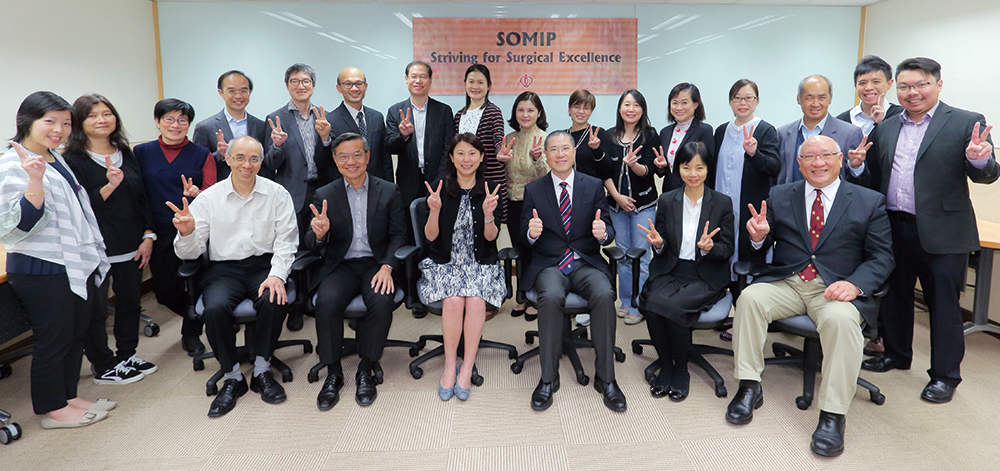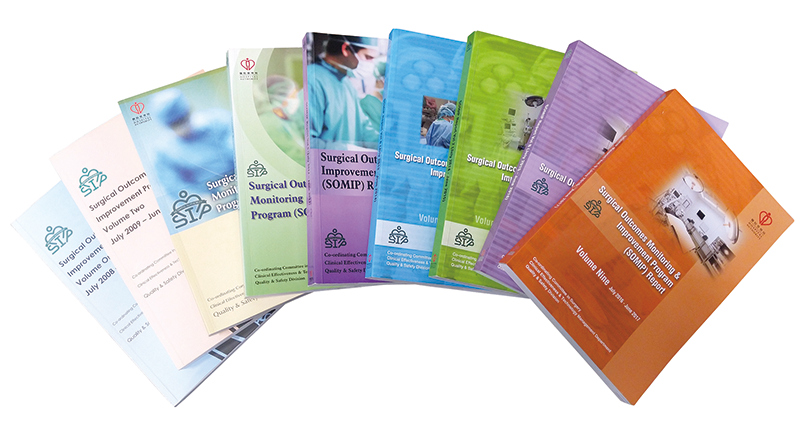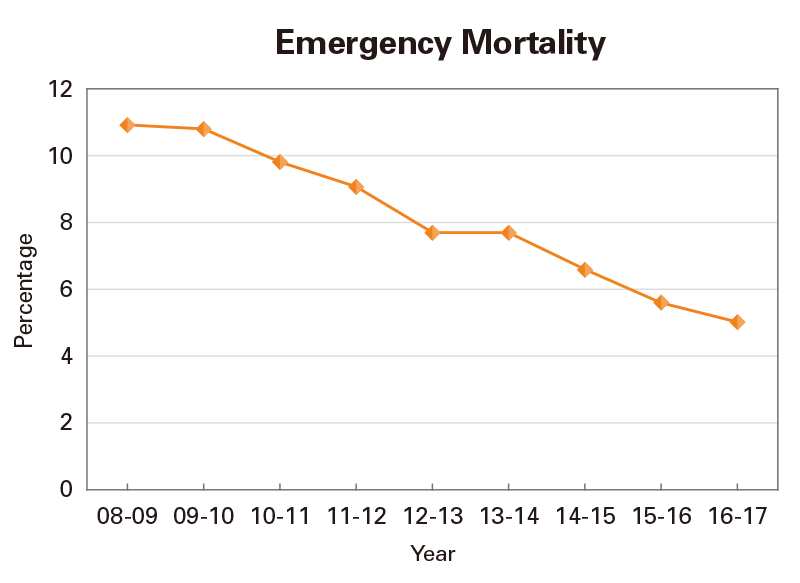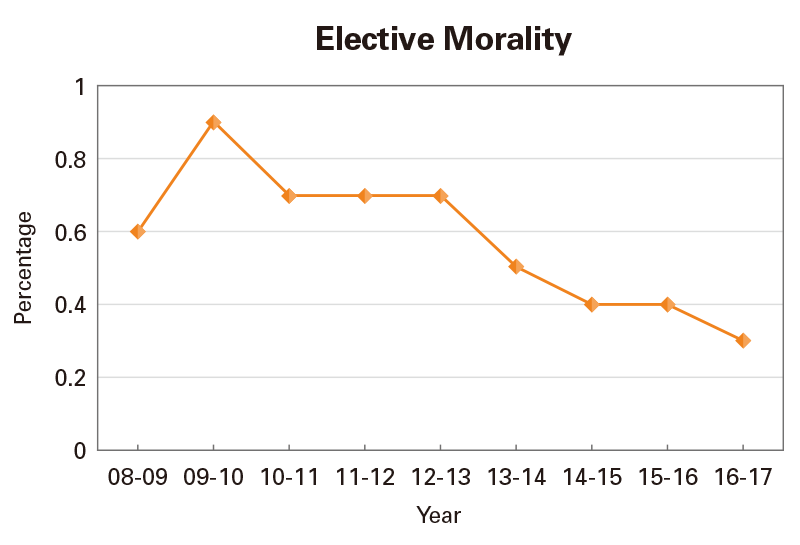Surgical Outcomes Monitoring and Improvement Program Team
Hospital Authority Head Office
Surgeons go hand in hand to enhance surgical efficiency
It is the mission of Hospital Authority to safeguard the life of each and every citizen, which underlines the importance of self-monitoring plays in maintaining service quality. As one of the outstanding team award winners, the team of Surgical Outcomes Monitoring and Improvement Program (SOMIP) adheres to the ‘hamburger’ principle in the past decade – the taste and texture of hamburgers of the same brand should remain unchanged whether you buy it in outlets located in Central or Tsuen Wan which analogises the consistent standard of HA services and surgical outcomes regardless of where patients receive medical care.
Prof Paul Lai Bo-san, Chairman of the SOMIP Steering Committee and Honorary Chief of Service (Surgery) of Prince of Wales Hospital says, “The most remarkable thing is that the program met with wide support from frontline doctors who sincerely want to improve service quality.” Dr Yuen Wai-cheung, Ex-chairman of the SOMIP Steering Committee and Honorary Consultant (Surgery) of Ruttonjee Hospital recalls how the program fell short of startup funding back in 2006, when it was allocated only 1.2 million of the six million required for commencement based on initial estimation. However, the program was rescued by Dr Cheng Man-yung right before its abandonment, who encouraged Dr Yuen to take the first step and see how it could proceed. Dr Yuen later used the funding to establish a centralised computer system for data processing from various hospitals and subsequent analysis of surgical efficiency. In the following year, he recruited part-time workers for data capturing, until 2008 when they officially formed a team with seven full-time nurses responsible for the implementation of program.
SOMIP aims to analyse the efficacy of emergency and elective surgeries based on the data collected from 17 public hospitals with surgical departments to enhance service quality. The initial results of SOMIP are released in November every year alongside media workshops. The complete report will then be distributed among the healthcare staff in the following year in January, including all the data findings and analyses for the reference and follow up of medical staff in the respective departments, as well as discussion in annual forum.
Prof Francis Mok, Advisor of the SOMIP Steering Committee and Consultant (Surgery) of Caritas Medical Centre admits how the program was considered controversial due to doubts on the accuracy of analysis outcomes and the potential effects on work morale, as the release of results from hospitals not up to standard might bring immediate criticisms on the colleagues in these corresponding hospitals. However, the team made painstaking effort to ease the worries of management and frontline colleagues in different hospitals, reiterating the aim of the program and how the team also sails on the same boat with colleagues and has no intention in picking on their mistakes.
The team will take follow-up actions or pay visits to particular hospitals to discuss corresponding strategies with colleagues after the publication of the SOMIP annual report. Prof Lai gives an example: a hospital showed relatively weak performance on emergency surgeries in the year 2012-13. After the macro-level analysis of data, the team found that the cause could be traced back to the lack of beds in the intensive care ward, leaving some patients in the surgical ward for post-operative care. The team thus recommended increasing the number of high-dependent care beds in the surgical ward for patients with appointments and freeing the beds in Intensive Care Unit for the post-operative care of patients after emergency surgeries to reduce the mortality rate.
He extends his gratitude to over 10 mid-level specialists in various hospitals who take up bridging roles to speak about challenges they face and share the strategies they learn from other hospitals with fellow colleagues every three months. Prof Lai emphasises, “We hope to encourage interaction between colleagues in different hospitals for overall improvement and quality care for patients.” The team seeks to lower the rate of complications and extend the self-monitoring program to other specialties.

● Young Achievers pull out all the stops
YOUNG ACHIEVER
● List of young achiever winners
● Small screw makes a big difference in ward
● The compass of healthcare planning
● Passionate scientist develops rapid tests
● Master key man starts occupational safety from staircases
● Fully committed to saving lives from heart
● Nurses light up in patients’ limping road of treatment
● Practical upgrade quality and quantity of PCI service in acute myocardial infarction
● Exercise is key to rehabilitation
● Quick training for new nurses to meet challenges at ease
OUTSTANDING STAFF
● List of outstanding staff winners
● Creative handicrafts help patients restore confidence
● Bring joy to kids during journey against disease
● Pioneer transforms nurse clinic into an integrated sanctuary of care
● Nurturing midwives to ‘walk with women’
● Leader with magnetic personality keeps top team together
OUTSTANDING TEAM
● List of outstanding team winners
● Fulfil the final blessing of life
● HA information at your fingertips
● High-tech simulation enhances task mastery
● A closer look at training equipment
● Replant for a complete body in all endeavours
● Essential tools for replantation surgery
● A dignified end-of-life journey
● Procedures of end-of-life services
● Surgeons go hand-in-hand to enhance surgical efficiency
● Fitter for speedier recovery in operation journey
MERIT LIST
STAFF CORNER




